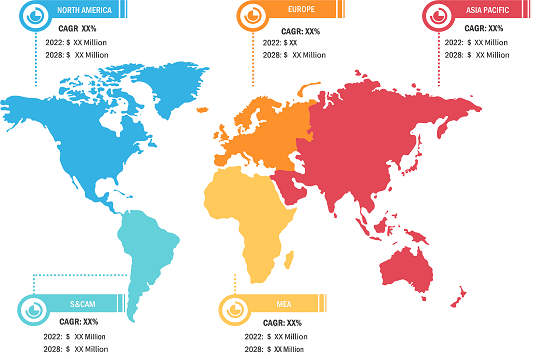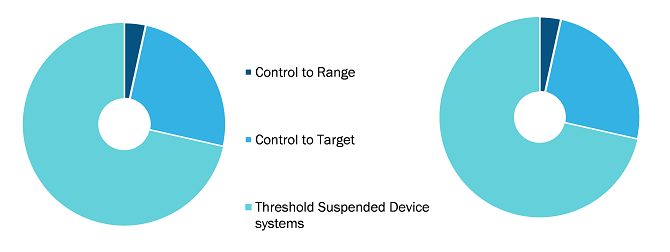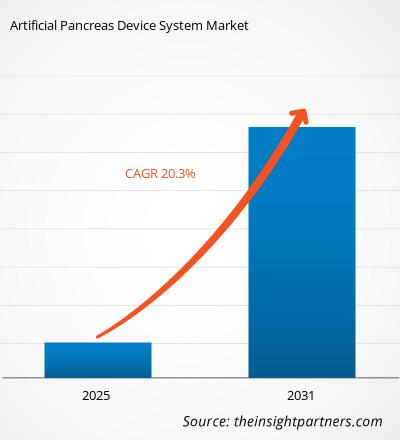Der Markt für künstliche Bauchspeicheldrüsengerätesysteme wird bis 2031 voraussichtlich 3.585,75 Millionen US-Dollar erreichen 1.190,23 Millionen im Jahr 2022; Von 2022 bis 2031 wird ein durchschnittliches jährliches Wachstum von 20,28 % erwartet.
Künstliche Bauchspeicheldrüsen-Gerätesysteme ahmen die glukoseregulierende Funktion der gesunden Bauchspeicheldrüse genau nach. Das Gerät überwacht nicht nur den Glukosespiegel im Körper, sondern passt auch automatisch die Insulinverteilung an, um den Blutzuckerspiegel zu senken und das Auftreten eines niedrigen Blutzuckerspiegels zu senken, ohne dass der Patient etwas dazu beitragen muss. Nach Angaben der Food and Drug Administration ist die Verwendung einer künstlichen Bauchspeicheldrüse bei Menschen mit Typ-1-Diabetes mit einer besseren Kontrolle des Blutzuckerspiegels im Vergleich zur Standardbehandlung verbunden.
Der Markt für künstliche Bauchspeicheldrüsengeräte ist nach Typ und Geografie segmentiert. Basierend auf der Geographie ist der Markt grob in Nordamerika, Europa, den asiatisch-pazifischen Raum, den Nahen Osten und den Nahen Osten unterteilt. Afrika sowie Süd- und Afrika Zentralamerika. Der Bericht bietet Einblicke und eine eingehende Analyse des Marktes, wobei der Schwerpunkt auf Parametern wie Markttrends, technologischen Fortschritten und Marktdynamik sowie der Analyse der Wettbewerbslandschaft der weltweit führenden Marktteilnehmer liegt.
Strategische Einblicke
Lukrative Regionen für den Markt für künstliche Bauchspeicheldrüsengerätesysteme< /span>

Markteinblicke
Wachsende Prävalenz von Diabetes stärkt den Markt für künstliche Bauchspeicheldrüsen-Gerätesysteme< /h3>
Diabetes ist eine lebensbedrohliche chronische Krankheit, für die es keine spezielle Heilung gibt. Die Krankheit wird hauptsächlich dadurch verursacht, dass der Körper nicht in der Lage ist, das Hormon Insulin zu produzieren oder effektiv zu nutzen. Es handelt sich um einen der größten globalen Gesundheitsnotfälle des 21. Jahrhunderts. Diabetes verhindert, dass der Körper den Blutzuckerspiegel ausreichend regulieren kann. Es gibt zwei Arten von Diabetes, nämlich Diabetes Typ I (auch Diabetes insipidus genannt) und Diabetes Typ II (auch Diabetes mellitus genannt). Fettleibigkeit, Bewegungsmangel und ungesunde Essgewohnheiten sind die Hauptrisikofaktoren, die mit der schnell wachsenden Zahl an Diabetikern verbunden sind.
Laut der International Diabetes Federation (IDF) wird die Zahl der Menschen mit Diabetes in Nordamerika voraussichtlich von etwa 46 Millionen im Jahr 2017 auf etwa 62 Millionen im Jahr 2045 steigen; Die Krankheitsprävalenz dürfte im Prognosezeitraum um etwa 35 % ansteigen. Nach Angaben der American Diabetes Association litten etwa 30,3 Millionen Menschen, also bis zu 9,4 % der US-Bevölkerung, an Diabetes; Davon litten im Jahr 2017 1,25 Millionen Kinder an Diabetes Typ I. Die National Institutes of Health geben außerdem an, dass die Inzidenz von Diabetes Typ I weltweit rapide zunimmt und eine beträchtliche Anzahl von Kindern und Jugendlichen betroffen ist. Laut derselben Quelle leiden im Jahr 2017 etwa 84 Millionen Menschen in Südostasien an Diabetes. Von diesen Patienten leiden 149.300 Kinder an Diabetes Typ I und benötigen eine tägliche Dosis Insulinspritzen. Typ-2-Diabetes ist die häufigste Form von Diabetes und hat im Zuge kultureller und gesellschaftlicher Veränderungen zugenommen. In Ländern mit hohem Einkommen leiden bis zu 91 % der erwachsenen Diabetiker an Typ-2-Diabetes. Nach Angaben der IDF lebten im Jahr 2017 etwa 425 Millionen Menschen auf der Welt mit Diabetes, und es wird erwartet, dass diese Zahl bis 2045 629 Millionen erreichen wird.
Diabetes aller Art kann zu verschiedenen Komplikationen in vielen Teilen des Körpers führen und das Gesamtrisiko eines vorzeitigen Todes erhöhen. Herzinfarkt, Schlaganfall, Nierenversagen, Beinamputation, Sehverlust und Nervenschäden sind die Hauptkomplikationen dieser Krankheit. Patienten mit Diabetes benötigen eine häufige Überwachung und externe Insulinverabreichung.
Type Insights
Basierend auf dem Typ, der künstlichen Bauchspeicheldrüse Der Markt für Gerätesysteme ist in Gerätesysteme mit Reichweitenkontrolle, Zielkontrolle und Schwellenwert-Gerätesysteme unterteilt. Im Jahr 2022 hielt das Segment der schwellengebundenen Gerätesysteme den größten Marktanteil. Darüber hinaus wird erwartet, dass das Segment im Zeitraum 2022–2031 die höchste CAGR verzeichnen wird. Bei Threshold-Suspend-Gerätesystemen, auch Low-Glucose-Suspend-Systeme genannt, wird die Insulinabgabe für eine festgelegte Zeit unterbrochen, wenn zwei Glukosewerte unter einem bestimmten niedrigen Wert liegen, was auf eine Hypoglykämie hinweist. Ein schwellenwertabhängiges Gerät hilft dabei, den Abfall des Blutzuckerspiegels umzukehren. Bei Threshold-Suspend-Gerätesystemen, auch Low-Glucose-Suspend-Systeme genannt, wird die Insulinabgabe für eine festgelegte Zeit ausgesetzt, wenn zwei Glukosespiegel unter einem bestimmten niedrigen Wert liegen. Geräte mit Schwellenwertsuspension können nicht auf ein Ereignis mit niedrigem Blutzuckerspiegel (Hypoglykämie) reagieren.
Markt für Systeme für künstliche Bauchspeicheldrüsengeräte, nach Typ – 2022 und 2031

Produkteinführungen sowie Fusionen und Übernahmen sind die am weitesten verbreiteten Strategien von Unternehmen, die auf dem globalen Markt für Gerätesysteme für die künstliche Bauchspeicheldrüse tätig sind. Nachfolgend sind einige der wichtigsten Produktentwicklungen aufgeführt:
- Im Juni 2021 erhielt Medtronic die CE-Kennzeichnung für das MiniMed 780G-System zur Heilung von Typ-1-Diabetes-Patienten im Alter von 7 bis 80 Jahren volljährig.
- Im April 2022 arbeitete Abbott mit Ypsomed und CamDiab zusammen, um das künstliche Bauchspeicheldrüsensystem nach Europa zu bringen.
- Im Januar 2021 brachte Medtronic sein MiniMed 780G System in Großbritannien auf den Markt. Es handelt sich um ein fortschrittliches hybrides Insulinabgabesystem mit geschlossenem Kreislauf, das zur Behandlung von Typ-1-Diabetes bei Menschen im Alter von 7 bis 80 Jahren eingesetzt wird.
Markt für künstliche Bauchspeicheldrüsengerätesysteme – Marktsegmentierung
Vom Typ her die künstliche Bauchspeicheldrüse Der Markt für Gerätesysteme ist in Gerätesysteme mit Reichweitenkontrolle, Zielzielkontrolle und Gerätesysteme mit Schwellenwertaufhängung unterteilt. Basierend auf der Geografie ist der Markt in Nordamerika (USA, Kanada, Mexiko), Europa (Frankreich, Deutschland, Großbritannien, Italien, Spanien und übriges Europa) und den asiatisch-pazifischen Raum (China, Japan, Indien, Australien, Südkorea) unterteilt , und Rest des asiatisch-pazifischen Raums), Naher Osten & Afrika (Saudi-Arabien, Südafrika, Vereinigte Arabische Emirate und Rest des Nahen Ostens und Afrikas), Süd- und Mittelamerika (Brasilien, Argentinien und Rest Süd- und Mittelamerikas)
Firmenprofile
- Defymed
- Typezero Technologies, Inc
- Insulet Corporation
- Bigfoot Biomedical, Inc
- Medtronic
- Dexcom, Inc
- Admetsys
- Beta Bionics
- Cellnovo
- Tandem Diabetes Care, Inc
- Historische Analyse (2 Jahre), Basisjahr, Prognose (7 Jahre) mit CAGR
- PEST- und SWOT-Analyse
- Marktgröße Wert/Volumen – Global, Regional, Land
- Branche und Wettbewerbsumfeld
- Excel-Datensatz

Report Coverage
Revenue forecast, Company Analysis, Industry landscape, Growth factors, and Trends

Segment Covered
This text is related
to segments covered.

Regional Scope
North America, Europe, Asia Pacific, Middle East & Africa, South & Central America

Country Scope
This text is related
to country scope.
Trends and growth analysis reports related to Life Sciences : READ MORE..
The List of Companies
- Defymed
- TypeZero Technologies, Inc.
- Insulet Corporation
- Bigfoot Biomedical, Inc.
- Medtronic
- Dexcom, Inc.
- Admetsys
- Beta Bionics
- Cellnovo
- Tandem Diabetes Care
The Insight Partners performs research in 4 major stages: Data Collection & Secondary Research, Primary Research, Data Analysis and Data Triangulation & Final Review.
- Data Collection and Secondary Research:
As a market research and consulting firm operating from a decade, we have published and advised several client across the globe. First step for any study will start with an assessment of currently available data and insights from existing reports. Further, historical and current market information is collected from Investor Presentations, Annual Reports, SEC Filings, etc., and other information related to company’s performance and market positioning are gathered from Paid Databases (Factiva, Hoovers, and Reuters) and various other publications available in public domain.
Several associations trade associates, technical forums, institutes, societies and organization are accessed to gain technical as well as market related insights through their publications such as research papers, blogs and press releases related to the studies are referred to get cues about the market. Further, white papers, journals, magazines, and other news articles published in last 3 years are scrutinized and analyzed to understand the current market trends.
- Primary Research:
The primarily interview analysis comprise of data obtained from industry participants interview and answers to survey questions gathered by in-house primary team.
For primary research, interviews are conducted with industry experts/CEOs/Marketing Managers/VPs/Subject Matter Experts from both demand and supply side to get a 360-degree view of the market. The primary team conducts several interviews based on the complexity of the markets to understand the various market trends and dynamics which makes research more credible and precise.
A typical research interview fulfils the following functions:
- Provides first-hand information on the market size, market trends, growth trends, competitive landscape, and outlook
- Validates and strengthens in-house secondary research findings
- Develops the analysis team’s expertise and market understanding
Primary research involves email interactions and telephone interviews for each market, category, segment, and sub-segment across geographies. The participants who typically take part in such a process include, but are not limited to:
- Industry participants: VPs, business development managers, market intelligence managers and national sales managers
- Outside experts: Valuation experts, research analysts and key opinion leaders specializing in the electronics and semiconductor industry.
Below is the breakup of our primary respondents by company, designation, and region:

Once we receive the confirmation from primary research sources or primary respondents, we finalize the base year market estimation and forecast the data as per the macroeconomic and microeconomic factors assessed during data collection.
- Data Analysis:
Once data is validated through both secondary as well as primary respondents, we finalize the market estimations by hypothesis formulation and factor analysis at regional and country level.
- Macro-Economic Factor Analysis:
We analyse macroeconomic indicators such the gross domestic product (GDP), increase in the demand for goods and services across industries, technological advancement, regional economic growth, governmental policies, the influence of COVID-19, PEST analysis, and other aspects. This analysis aids in setting benchmarks for various nations/regions and approximating market splits. Additionally, the general trend of the aforementioned components aid in determining the market's development possibilities.
- Country Level Data:
Various factors that are especially aligned to the country are taken into account to determine the market size for a certain area and country, including the presence of vendors, such as headquarters and offices, the country's GDP, demand patterns, and industry growth. To comprehend the market dynamics for the nation, a number of growth variables, inhibitors, application areas, and current market trends are researched. The aforementioned elements aid in determining the country's overall market's growth potential.
- Company Profile:
The “Table of Contents” is formulated by listing and analyzing more than 25 - 30 companies operating in the market ecosystem across geographies. However, we profile only 10 companies as a standard practice in our syndicate reports. These 10 companies comprise leading, emerging, and regional players. Nonetheless, our analysis is not restricted to the 10 listed companies, we also analyze other companies present in the market to develop a holistic view and understand the prevailing trends. The “Company Profiles” section in the report covers key facts, business description, products & services, financial information, SWOT analysis, and key developments. The financial information presented is extracted from the annual reports and official documents of the publicly listed companies. Upon collecting the information for the sections of respective companies, we verify them via various primary sources and then compile the data in respective company profiles. The company level information helps us in deriving the base number as well as in forecasting the market size.
- Developing Base Number:
Aggregation of sales statistics (2020-2022) and macro-economic factor, and other secondary and primary research insights are utilized to arrive at base number and related market shares for 2022. The data gaps are identified in this step and relevant market data is analyzed, collected from paid primary interviews or databases. On finalizing the base year market size, forecasts are developed on the basis of macro-economic, industry and market growth factors and company level analysis.
- Data Triangulation and Final Review:
The market findings and base year market size calculations are validated from supply as well as demand side. Demand side validations are based on macro-economic factor analysis and benchmarks for respective regions and countries. In case of supply side validations, revenues of major companies are estimated (in case not available) based on industry benchmark, approximate number of employees, product portfolio, and primary interviews revenues are gathered. Further revenue from target product/service segment is assessed to avoid overshooting of market statistics. In case of heavy deviations between supply and demand side values, all thes steps are repeated to achieve synchronization.
We follow an iterative model, wherein we share our research findings with Subject Matter Experts (SME’s) and Key Opinion Leaders (KOLs) until consensus view of the market is not formulated – this model negates any drastic deviation in the opinions of experts. Only validated and universally acceptable research findings are quoted in our reports.
We have important check points that we use to validate our research findings – which we call – data triangulation, where we validate the information, we generate from secondary sources with primary interviews and then we re-validate with our internal data bases and Subject matter experts. This comprehensive model enables us to deliver high quality, reliable data in shortest possible time.



 Holen Sie sich ein kostenloses Muster für diesen Bericht
Holen Sie sich ein kostenloses Muster für diesen Bericht